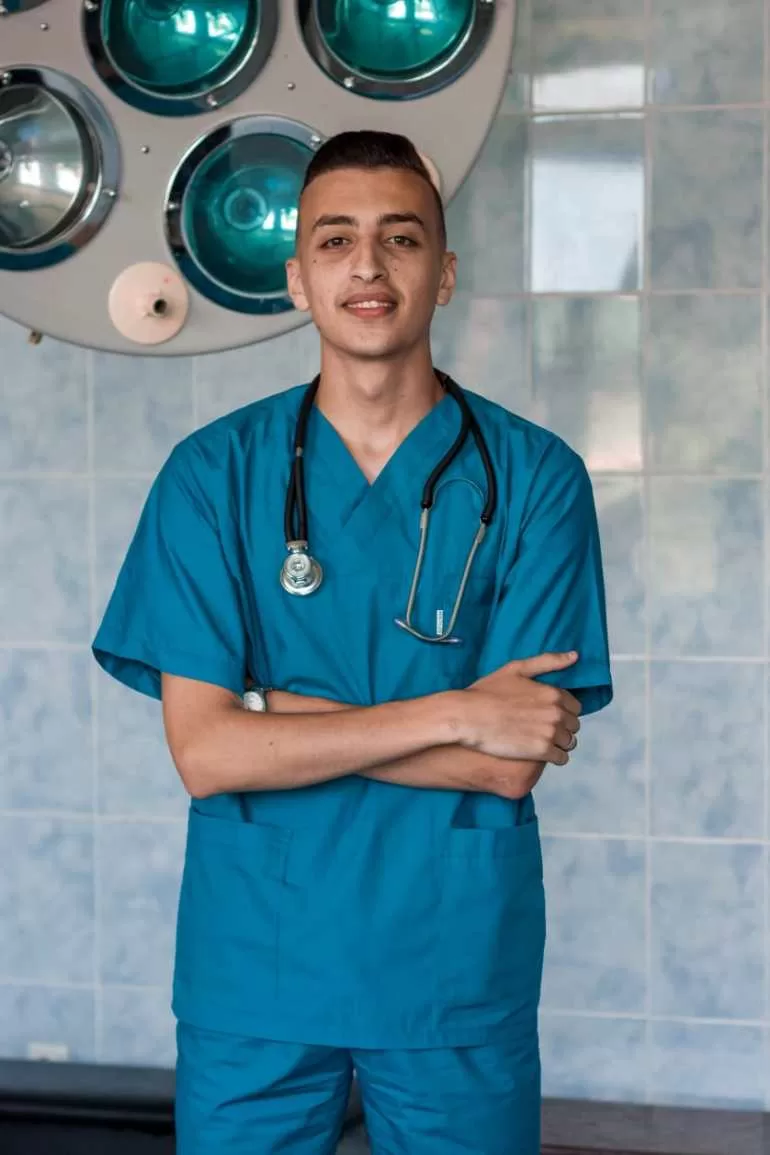The 25-year-old who recently started his medical career had to stitch up a little boy whose body was pierced all over by shrapnel – at least 14 open wounds covered his body, from “head to toe”.
There was no anaesthesia to be had. Al-Buhaisi stitched each one closed, a process that took two whole hours.
The boy was “maybe 10 years old, maximum”, al-Buhaisi said, sitting outside Al-Aqsa Martyrs Hospital in Deir el-Balah.
“His screams will forever haunt me.”
Al-Buhaisi thought he was already war-hardened after he came back from his eight years studying medicine in Ukraine and volunteering to help the wounded when Russia invaded in 2022.
After working in several hospitals, including in and around the capital Kyiv, he decided to return home for his final year of residency, intending to “serve” his people in Gaza.
Shortly after his return and the start of his residency, Israel unleashed its most brutal assault yet on the besieged territory following the October 7 Hamas attacks.
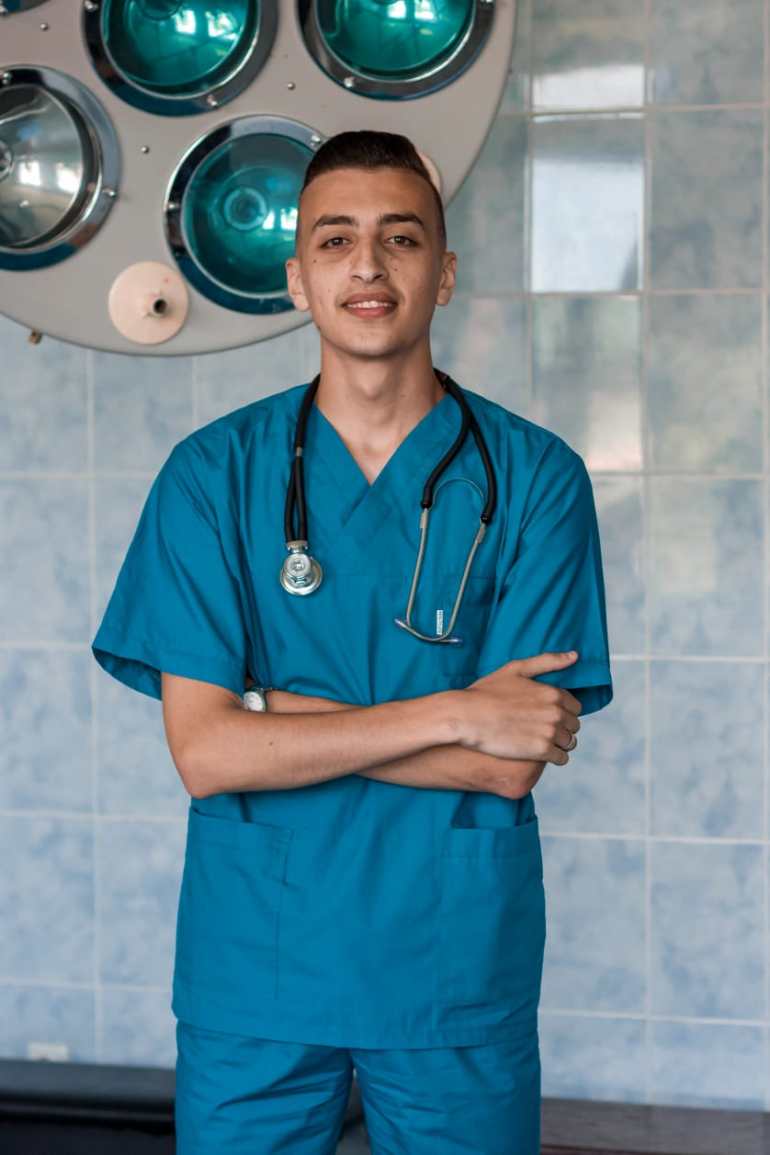
“They call me the ‘War Man’ – wherever I go, war breaks out,” he said.
On the evening when the Israeli assault began, it was only al-Buhaisi’s third shift ever in the hospital’s emergency unit.
He is pretty sure that what he has seen as a “fresh graduate” is more than what other medical professionals may see in their entire lifetimes.
“I’ve seen things that made me stop eating for a week … missing limbs, infected wounds, the entrails of women and children spilling on the hospital’s floors,” he recalled.
‘A personal choice’
After more than 100 days of relentless bombardment, as he works with little to no equipment, al-Buhaisi cannot help but wonder how things would have been for him if he never left Ukraine.
“When I decided to return to Gaza, it was a personal choice I was content with. I had no interest in obtaining a foreign passport and wanted to live close to my family and friends,” he said, adding that he missed the special charm and warmth that only Gaza has.
This longing was especially strong when he was trying to flee Ukraine during the early days of the Russian invasion.
He took a six-hour bus ride with some colleagues towards Ukraine’s border with Romania, followed by a 20km (12-mile) walk in sub-zero weather to the crossing.
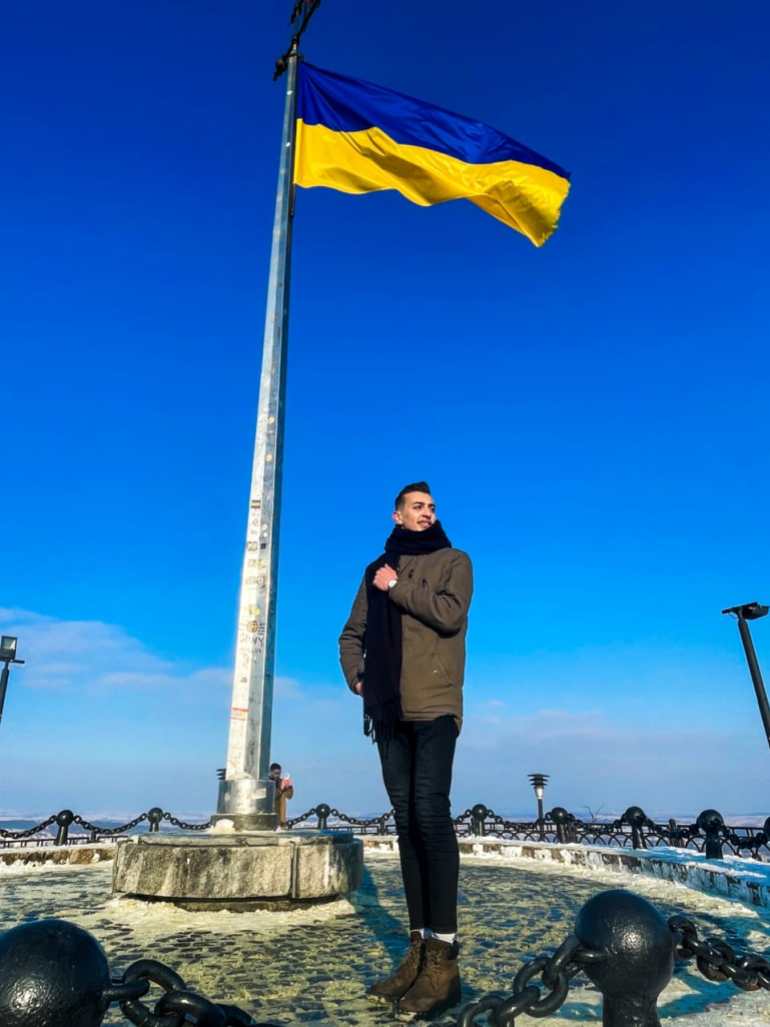
At the crossing, al-Buhaisi realised he had to leave his Ukrainian friends and join the “foreigners” queue.
“For every 30 Ukrainians, some three foreigners would be let in,” he said.
“We waited in line in the extreme cold for seven hours before we were finally allowed in,” he added. “I remember messaging my brother my final goodbyes because it felt like I was taking my very last breaths.”
Despite that ordeal, al-Buhaisi is aware that he was at least able to evacuate, something that some 2.3 million people trapped in Gaza cannot do.
‘War on hospitals’
He also cannot help but compare the state of the healthcare sector in Ukraine during the war to the situation in Gaza’s medical facilities.
Dubbed a “war on hospitals”, Israel’s attacks have not spared medical facilities, healthcare workers, ambulances, patients, as well as thousands of terrified internally displaced people sheltering inside hospitals.
At least 30 hospitals and 150 other medical facilities have been put out of service since October 7, according to Gaza’s information ministry.
The remaining few hospitals are working far beyond their capacity and have been acting as shelters for displaced people as well.
Israeli soldiers have killed some 337 health workers and arrested 99 others, the ministry said. Many of those in detention were brutally abused, while the fate of others remains unknown.
“I have not seen anything as horrific as what I’ve seen here in Gaza,” al-Buhaisi said of his time treating the wounded in Ukraine. “During an eight-hour shift, we would see around five cases.”
Al-Buhaisi described the Ukainian facilities he worked at as “readily stocked safe havens”, flooded with supplies. “Each doctor in emergency had their team, including three assisting nurses,” he said.
“Here in Gaza, most of the cases I treat are handled on the floor. My colleague and I juggle about six cases at a time,” he said.
‘Ethical dilemmas’
In a conflict, the main challenges faced by the healthcare system are the increased demand on human resources and supplies, and the difficulty in accessing facilities amid intense fighting.
“What we see in Gaza is all of the above on a much worse scale than any conflict in recent history,” Omar Abdel-Mannan, a pediatric neurologist and co-founder of Gaza Medic Voices, said.
According to him, the triage system “has well and truly collapsed in Gaza”, something that is “unprecedented”, he told Al Jazeera.
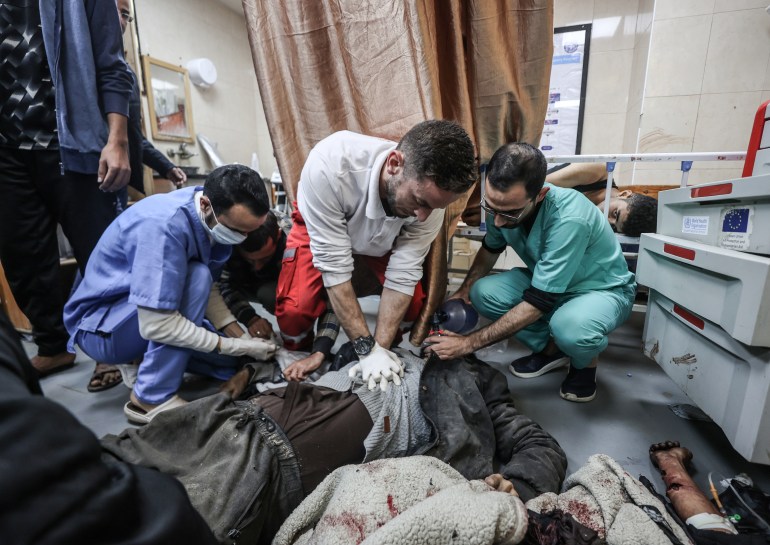
Abdel-Mannan said it is particularly worrying because patient triage is essential in any conflict.
“The even more concerning challenge, which we haven’t seen in other major conflicts, is the direct and systematic targeting of healthcare workers and facilities,” he added.
Even though more medics are needed, the number of medical professionals usually decreases in times of conflict, Ana Barbar, an expert on the protection of healthcare, said.
“The reality is that you might have even less people working … because they had to flee the area with their families,” Barbar told Al Jazeera.
What helped exacerbate an already bad situation is a crippling 17-year Israeli siege of Gaza that impeded the “natural flow” of supplies, she said.
Scaling up a health response means “you need more of everything: more workers to respond to higher demand,” as well as an increase in supplies, she added.
The severe lack of supplies, workers, hospital beds, and facilities has forced health workers in Gaza to make inhuman sacrifices and decisions, posing “ethical dilemmas for allocation of resources”, Barbar said.
“Suffering with immense moral distress and psychological toll, these healthcare workers must often make choices that are against normal practice,” she said.
Abdel-Mannan agreed, saying the number of patients pouring into hospital departments was huge from the early days of the assault, “leading to medics having to ‘play God’ by … having to decide who is salvageable and who is not”.
Al-Buhaisi was forced to make such a choice recently when he used the last sedative he had on a wounded boy who was in severe psychological distress.
“The boy was in seventh grade, and fully understood what had just happened to him and his family. I told him I needed to inspect his wound, but he wouldn’t let me touch him,” he recalled. “He wanted to know if his parents were alive.”
They were not, but: “I couldn’t tell him that, it would have made things worse and would have prevented me from being able to treat him,” he said.
“That’s when I made the call and grabbed the pill,” he said. “I thought, if anyone needed to be calmed down before receiving the news of his parents’ death, it was this wounded boy.”
The scale of medical needs is “so immense,” Marie-Aure Perreaut, emergency coordinator in Gaza for Doctors Without Borders – also known as Médecins Sans Frontières (MSF) – said.
“No truck counts will ever match these,” Perreaut told Al Jazeera.
Currently, the aid coming into Gaza through the Rafah border crossing meets less than 30 percent of the enclave’s needs, according to Ashraf al-Qudrah, spokesman for the Health Ministry.
Both the quantity and type of aid are controlled by Israel, which has imposed a complete siege on Gaza since the start of the offensive.
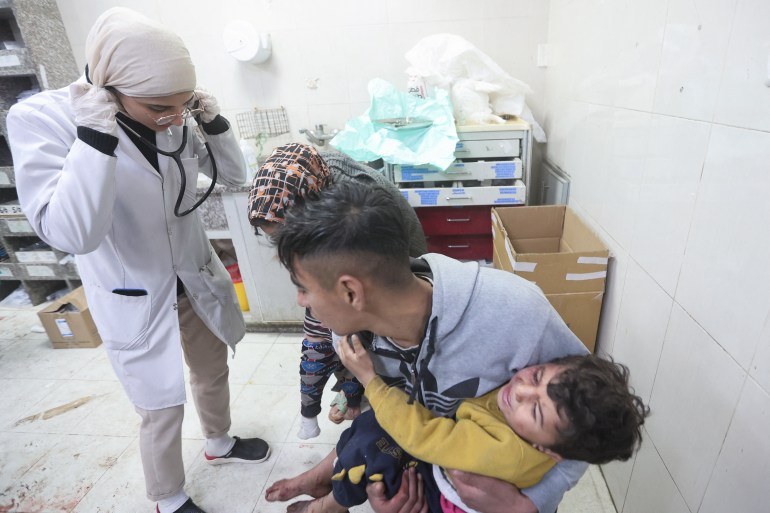
Rationing the use of painkillers and other supplies is one of the “many impossible equations” humanitarian workers have to deal with in Gaza, Perreaut said.
She recalled MSF staff working without some of the most “basic surgical supplies”, dressing the wounds of babies who had had limbs amputated, and women with second-degree burns.
‘Impossible’ to flee
In Gaza, most of the people injured are civilians, which is “quite unusual”, Guillemette Thomas, medical coordinator for Palestine MSF, told Al Jazeera.
“Most of the time, in all conflicts, civilians can flee and escape. In Gaza, it’s impossible. They’re targeted, they are in the middle of the conflict,” she said.
The hospitals themselves are not safe, as Israeli forces besiege, bombard, and raid hospitals across Gaza – including the enclave’s largest, al-Shifa Hospital. Most recently, Israeli attacks have targeted Nasser Hospital in southern Gaza’s Khan Younis.
The attack on al-Shifa in November forced thousands of displaced families sheltering there to flee again and forced medical workers to decide between staying with patients who could not be transferred and fleeing for their own safety.
Throughout, there was little access to food, water, and virtually no electricity as what little fuel Gaza had ran out, with generators falling silent and lifesaving equipment stopping.
Forcing patients and health workers to vacate hospitals is “effectively sentencing all these patients and the new ones to death,” Perreault said.
The UN Office for the Coordination of Humanitarian Affairs (OCHA) said at least 1.7 million Palestinians have been internally displaced, many of them multiple times.
Adding to the crisis is the fact that medics often have to work with no information due to repeated telecommunication blackouts in Gaza.
Medics said they follow plumes of smoke to find where an attack has taken place, using the handful of ambulances that have not yet been bombed by Israel.
On at least nine occasions, near-total blackouts have cut Gaza’s residents off from the world and each other, according to Internet monitoring site Netblocks.
The last and longest blackout began on January 19, preventing people from accessing lifesaving information or calling first responders.
“Shutting down electricity and communication lines … are clear demonstrations of Israeli lack of intention to enable a dignified, effective and adequate health response,” Barbar said.
At least 45 civil defence workers have been killed by Israeli forces since October 7, Gaza’s media office said, adding that 122 ambulances had also been “directly targeted” so far.
According to OCHA, Israeli attacks targeted several telecommunication installations, destroying two out of three main lines.
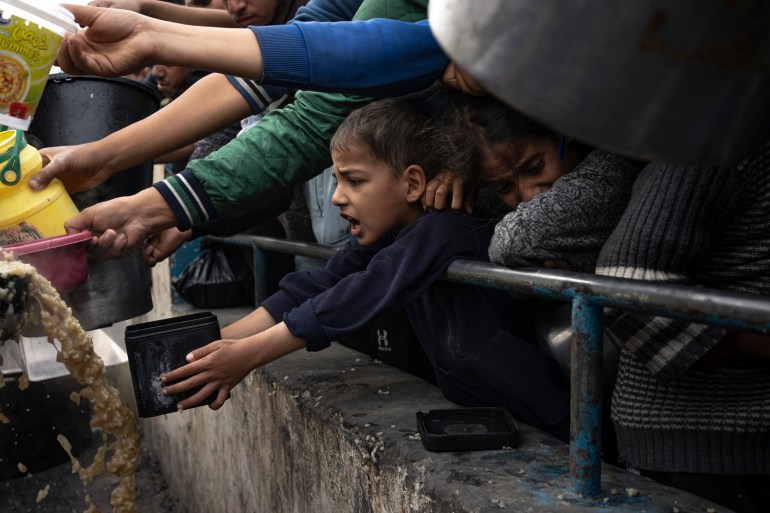
The blackouts not only hinder access to information, but also prevent authorities in Gaza from recording the accurate number of people killed, wounded, and still missing.
According to the health ministry, more than 25,000 people have been killed and 62,000 wounded in Israeli attacks on Gaza since October 7.
Medicine in Gaza, or treating patients with nothing
There is also a surge in epidemics among the displaced, with the health ministry warning of a sharp rise in respiratory illnesses, as well as food poisoning and kidney problems.
And, as the cold winter months set in, cases of flu, coughs and colds are on the rise, particularly among children.
Hygiene issues have also increased due to a severe lack of water and sanitation.
This is resulting in a “continual increasing excess mortality rate,” Gaza Medic Voices’s Abdel-Mannan said. “Children, women and men, dying from preventable diseases or diseases that could [have been] treated in non-war times,” he said.
“If I had to estimate, I’d say half of my 24-hour shift at the hospital is spent treating patients with diseases that are spreading in the shelters,” al-Buhaisi said.
“I can’t even prescribe patients the right treatment because it’s not available, even something as simple as a cold compress because there is no water,” he said.
His frustration was evident on his face and, trying to hide it, he turned to humour for a moment of respite.
Chuckling, he suggested writing a special book, “Medicine in Gaza”, that would include all the tips and tricks health workers use to treat patients with “virtually nothing”.
